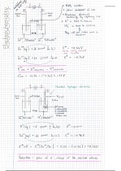Class notes
CIE A Level Chemistry - 20. Electrochemistry
- Course
- Institution
- Book
Notes for chapter 20 Electrochemistry from the CIE A Level Chemistry syllabus. Neat, hand-written notes, six pages long, include colourful diagrams and explanations of the main concepts important for the exam. Include the following sub-topics: electrochemical cells and half-cells, standard electrod...
[Show more]




